Key takeaways:
- Microfilm is a valuable genealogy tool, providing access to unique records like census data and church documents that may not be available digitally.
- Engaging with microfilm cultivates patience and a deeper connection to family history, enhancing the research experience through discovery.
- Organizing findings from microfilm is essential; using digital tools and themed folders can streamline the research process and preserve insights.
- Personal success stories, such as discovering naturalization papers and significant family events, illustrate the profound impact microfilm can have on understanding one’s ancestry.
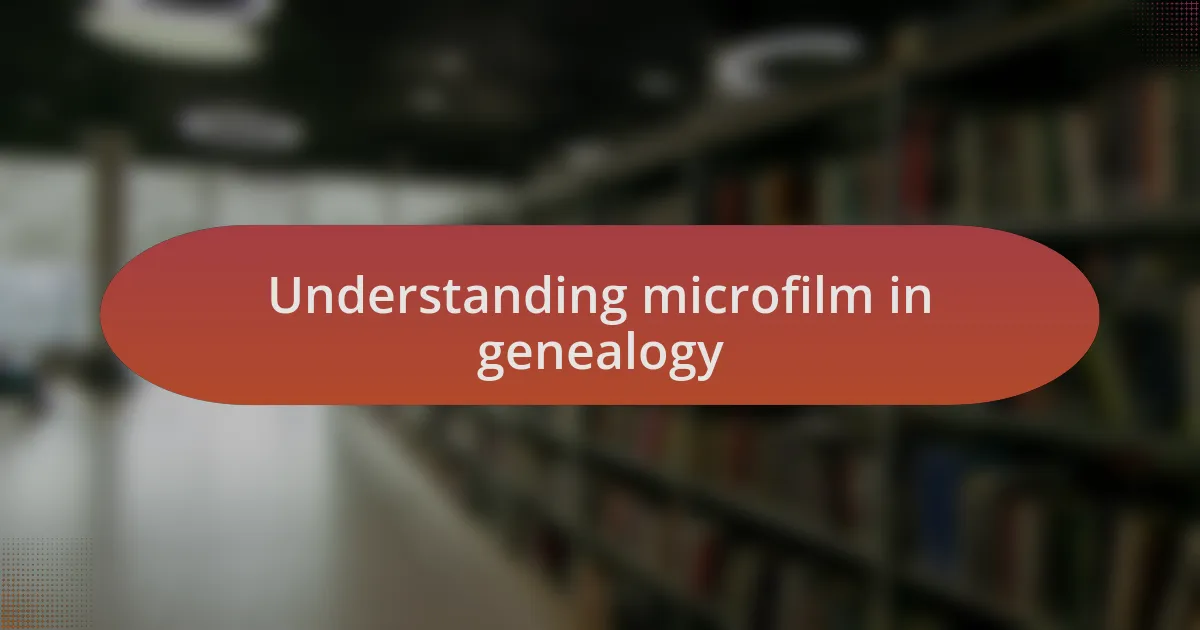
Understanding microfilm in genealogy
Microfilm is a remarkable tool in genealogy, often serving as a bridge between the past and present. I remember my first encounter with it at my local archive; the excitement of viewing decades-old records felt like stepping into a time machine. Why is it that something so seemingly outdated can hold the keys to our family history?
Many genealogists overlook microfilm, thinking it’s archaic. However, I’ve found that some of the most valuable records—like census data and church records—are often available only in this format. The thrill of scrolling through film reels, finding names and stories, can’t be matched by digital sources alone. Have you ever experienced that moment of discovery when you stumble upon a long-lost ancestor?
Microfilm’s durability makes it a reliable resource for preserving precious records. Unlike digital formats, which can easily become obsolete or corrupted, microfilm withstands the test of time. I’ve spent countless hours sifting through these tiny images, feeling that deep connection to my lineage; it’s about more than just data; it’s about family stories waiting to be uncovered.
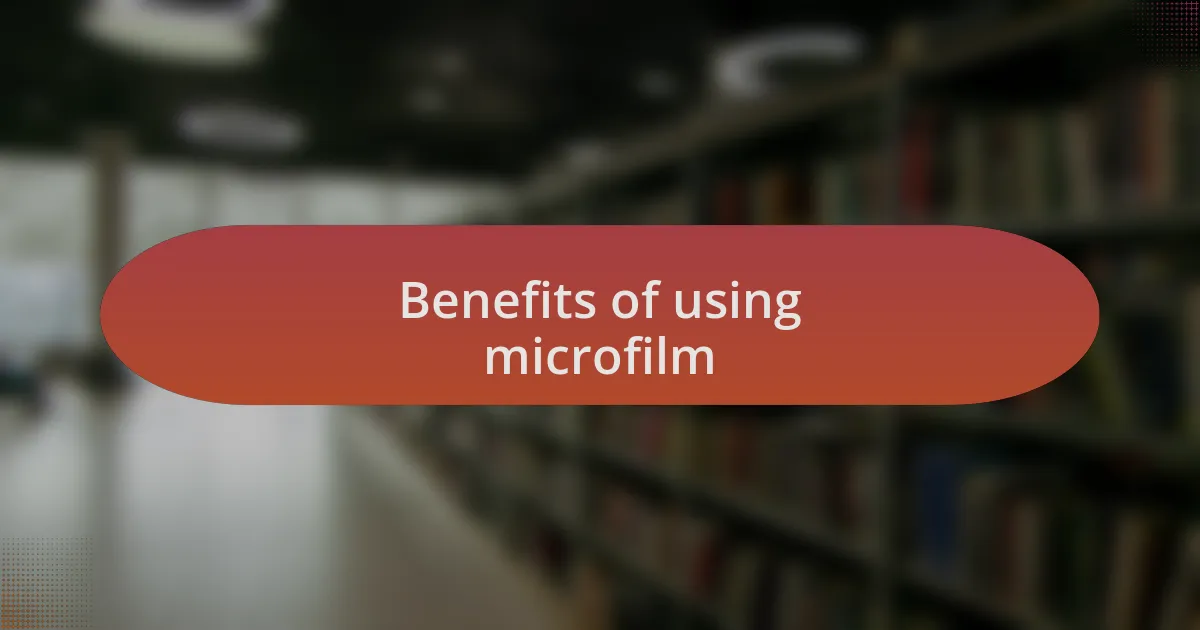
Benefits of using microfilm
Using microfilm has several benefits that many genealogists may not initially appreciate. For instance, when I first stumbled upon a collection of old city directories in microfilm format, it was like unlocking a hidden treasure trove. These directories not only listed families but also provided context about community interactions and changes over time, painting a richer picture of my ancestors’ lives. Have you ever thought about how much more you can learn from the little details that traditional digital searches might overlook?
One of the most compelling advantages of microfilm is its accessibility to a wealth of historical documents that aren’t digitized. I remember one particular visit to the library where I discovered a series of courthouse records on microfilm. There, I found not just vital statistics but actual court cases that gave insight into my ancestors’ struggles and triumphs. It made me appreciate the complexities of their lives beyond the dates and names often found in online databases.
Moreover, using microfilm also cultivates a unique sense of patience and discovery. As I navigated through those reels, I often found myself surprisingly captivated, almost meditative. Each frame felt like a puzzle piece waiting to connect to others I had already gathered. Have you considered how this slower pace could enhance your research experience, allowing you to revel in the process of digging through history?
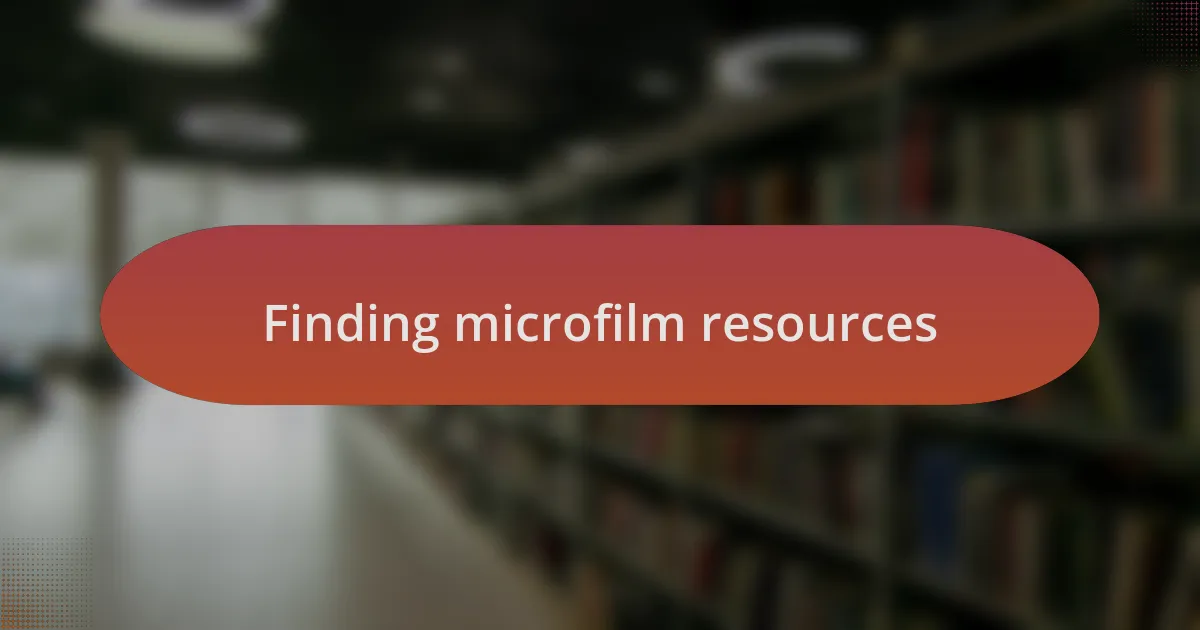
Finding microfilm resources
Finding microfilm resources can often feel like embarking on a treasure hunt. One of my favorite places to start has been local libraries, many of which have extensive microfilm collections. I recall my first visit to a small-town library; it was like stepping back in time. The librarian was incredibly helpful, guiding me to their archives where I found newspapers dating back decades. Have you ever considered how local resources can be one of the most underutilized tools in genealogy research?
Another valuable resource is FamilySearch, which offers a vast online catalog that lists where microfilm can be found. I was pleasantly surprised by the number of locations worldwide that had copies of the same microfilm I was searching for. It felt like putting together a global family tree, connecting me to others on similar quests. What if your next big breakthrough in finding an ancestor’s story was just a search away through these online catalogs?
Lastly, don’t overlook specialized archives or historical societies. When I joined my local historical society, I was introduced to a hidden gem of microfilm resources that weren’t available elsewhere. This membership allowed me to access unique documents that significantly advanced my research. Have you thought about how collaborating with local genealogists can open doors to resources you never knew existed?
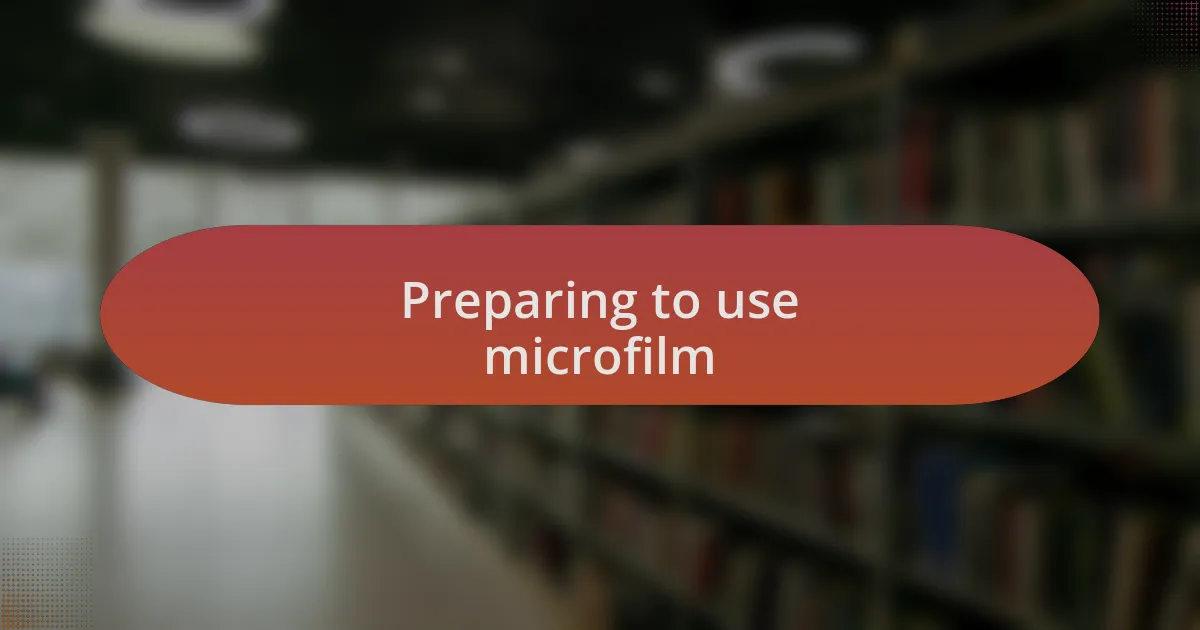
Preparing to use microfilm
When preparing to use microfilm, it’s essential to understand your goals clearly. I remember the excitement I felt as I jotted down the specific records I wanted to search for before heading to the library. Without a focused approach, I might have wandered aimlessly through reels of unfamiliar content, which can be overwhelming. Have you ever found yourself lost in a sea of documents, unsure of where to start?
Next, examining the equipment you’ll be using is crucial. I was surprised the first time I encountered a microfilm reader—it can seem archaic but also fascinating. Take a moment to familiarize yourself with the controls; knowing how to adjust the focus and brightness can significantly enhance your viewing experience. What if you could make that old text leap to life with just a simple twist of a knob?
Finally, don’t forget the importance of a notebook or digital device to take notes during your research. On my first outing, I was so eager to uncover family stories that I neglected to jot down valuable information. The result was a frenzied scramble to recall details after the visit. Have you ever had that moment of panic when you realize you can’t remember an important detail? By keeping notes, you ensure that every piece of information counts toward your genealogical puzzle.

Tips for effective microfilm reading
When actually reading microfilm, I find that patience is key. I remember sitting for hours, carefully scrolling through endless frames, as I waited for a particular name to pop up. It’s easy to get frustrated, especially if the text is blurry or faded. But I’ve learned that taking regular breaks can help maintain focus and prevent overwhelm. Have you ever noticed how stepping away for just a moment can lead to renewed clarity?
Taking the time to zoom in on the details can make a world of difference. One memorable day, I stumbled upon a birth certificate where the ink had faded, challenging my eyesight. I adjusted the zoom and brightness settings several times, transforming a nearly unreadable document into a legible treasure. This persistence paid off, as I was able to uncover crucial family information that would have otherwise passed unnoticed. I encourage you to embrace adjustments; sometimes a slight tweak reveals hidden gems.
Be sure to bookmark significant frames or use the note-taking feature if your microfilm reader allows it. I recall overlooking vital pages because I hadn’t marked them. It felt like losing a key piece of my family’s history, and I vowed not to let that happen again. Have you experienced that feeling of regret? Trust me, a quick note on a relevant page can save you hours during your next visit to the archive.
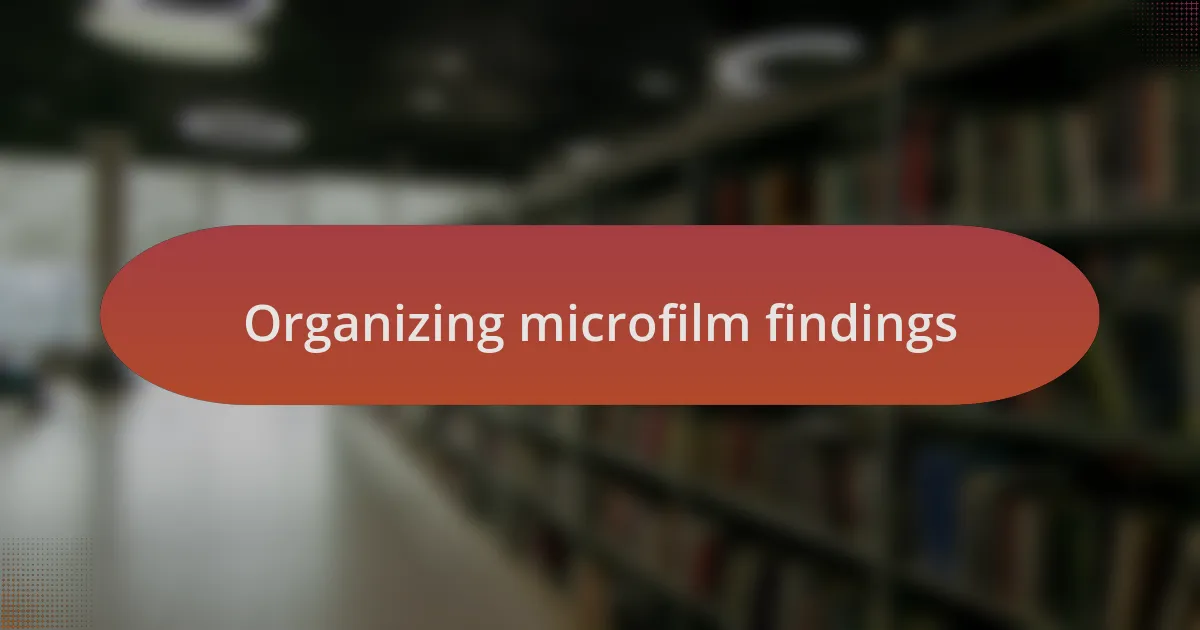
Organizing microfilm findings
Once you’ve collected your findings from microfilm, organizing them is crucial for effective research. I remember coming home after a particularly fruitful day at the archive, only to find myself buried in a jumble of notes and photocopies. I soon realized that using a digital spreadsheet to catalog each document by date, type, or family name made all the difference. Have you ever found yourself searching for a critical piece of information only to realize you didn’t document its location?
To keep even better track of my microfilm discoveries, I created themed folders, one for each branch of my family tree. This simple method allowed me to quickly reference my findings when I was compiling stories or making connections. I found that labeling each folder with a brief summary of its contents helped jog my memory, making it easier to dive back into my genealogy research. How satisfying is it to open a neatly organized folder filled with your ancestors’ stories, ready to piece together your family history?
Additionally, I would often jot down my thoughts and insights on sticky notes, attaching them directly to my digital files. This practice not only provided context but also captured my emotional responses to what I discovered. I still cherish the notes I wrote about personal connections I felt while learning more about my ancestors. Each one serves as a reminder of the journey of discovery, making my research not just about names and dates but about the lives lived before me.
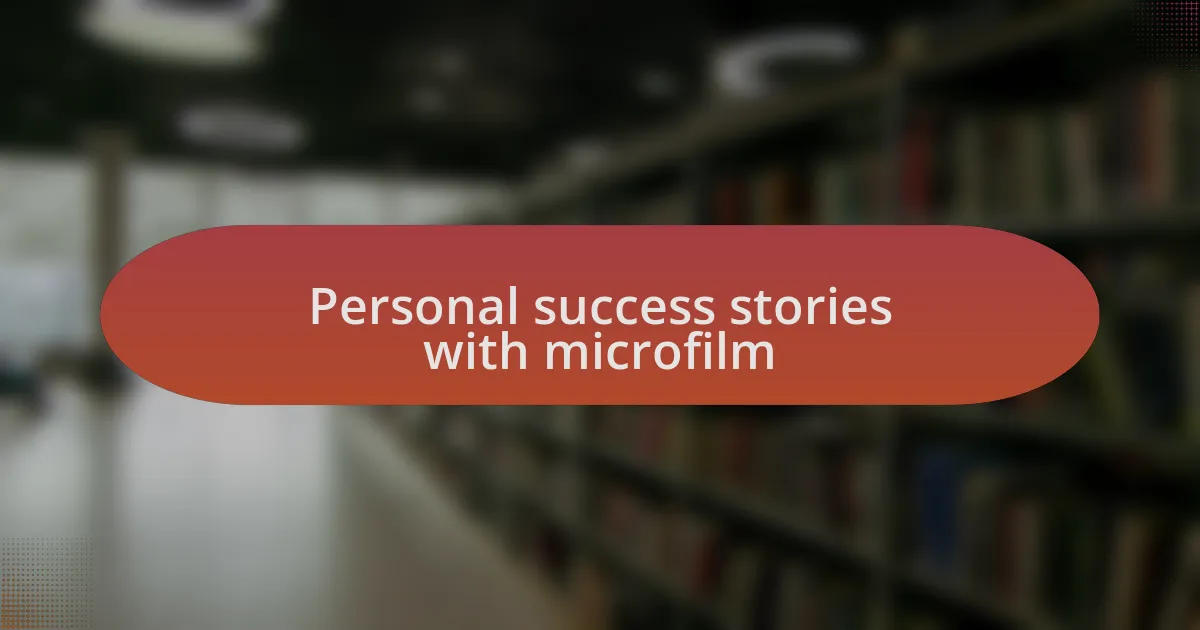
Personal success stories with microfilm
I recall one afternoon spent in the archives, where I stumbled upon a microfilm reel containing my great-grandfather’s naturalization papers. As I carefully scrolled through the film, a mix of excitement and anticipation washed over me. Suddenly, there it was: my ancestor’s signature—an inked testament to his dreams and struggles. Can you imagine holding a piece of history in your hands like that? It truly transformed my understanding of who he was and why he sought a new life.
Another remarkable moment came when I discovered a newspaper article on microfilm that detailed a family event from the 1920s. Reading about my grandmother’s wedding—complete with the names of her vibrant friends and family—brought the past alive in a way I hadn’t anticipated. I couldn’t help but wonder how these lively individuals shaped their world. It reminded me that genealogy is not just about tracing lineage; it’s about bringing to light the vibrant lives that form the roots of our stories.
As I dove deeper into this treasure trove of information, I found it rewarding to unearth unexpected connections between my ancestors and significant historical events. One day, I learned that a family member had been involved in a local labor movement, sparking a fire in my heart. It made me ponder how their resilience and activism spilled into the fabric of our family legacy. Have you ever made a discovery that shifted your perception of your ancestors? These moments of revelation turned what I initially perceived as mere facts into rich narratives that still resonate with me.